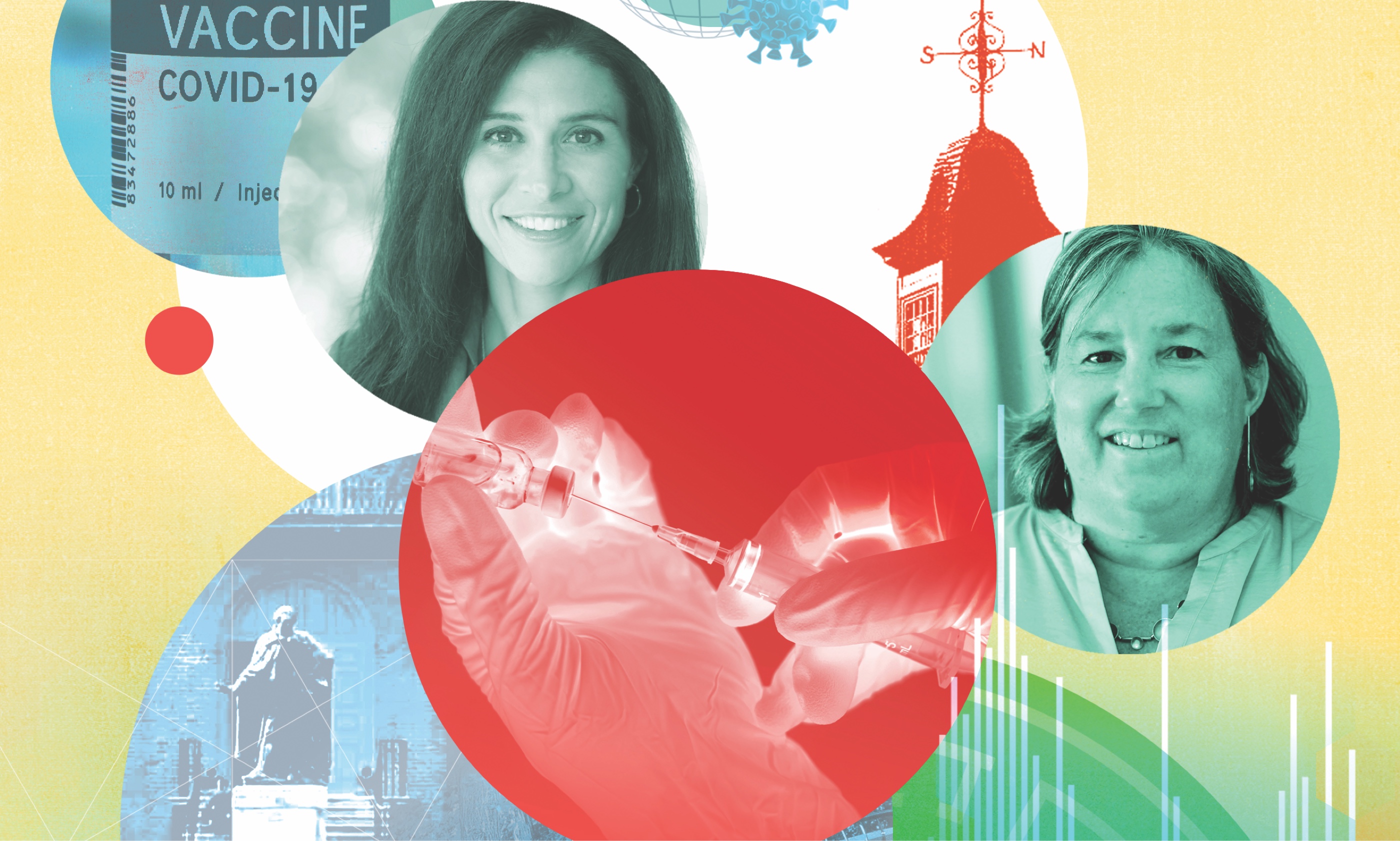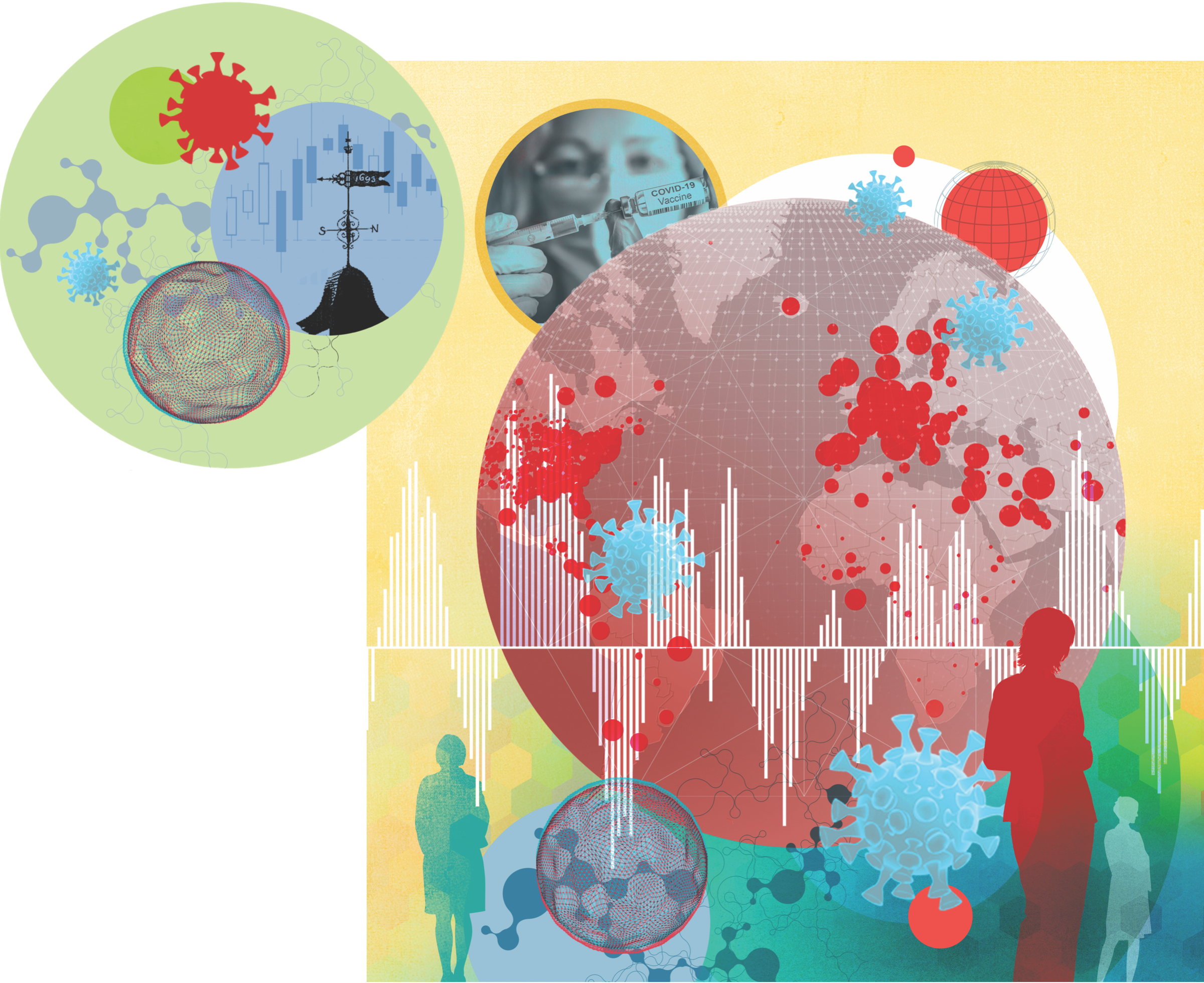Melissa J. Moore ’84 still gets shivers when she thinks about Nov. 30, 2020. It was on that Monday when Moderna Inc. — the startup biotech company she had joined on a leap of faith — unveiled results of clinical trials showing its COVID-19 vaccine was even more effective in protecting against the virus than she had hoped — over 94%.
Path to a Vaccine
W&M alumnae play key roles in making sure COVID-19 immunizations are safe and accessible
January 19, 2022
By
Tina Eshleman
and
Katherine Vermilyea '22
Illustrations By
Stephanie Dalton Cohen
First confirmed in the United States less than a year earlier on Jan. 21, 2020, the virus had caused over 267,000 deaths in America and 1.4 million worldwide by that point. With no effective treatment available at the time, a vaccine offered the best hope to stop the disease from spreading.
Moore, who was then the chief scientific officer for platform research at the Massachusetts-based company, drew on her extensive research into the synthesis machinery of cells to support the company’s vaccine development.
“Ten years of hard work led to us having all the resources in the right place at the right time to create this vaccine in short order,” Moore says.
She and two other William & Mary alumnae — Candice Malone Long M.B.A. ’96 at Johnson & Johnson and Colleen Gorman ’95 at Pfizer — have played an integral part in making their companies’ COVID-19 vaccines available to the public.
As U.S. president of Janssen Infectious Diseases & Vaccines with Johnson & Johnson since June 2020, Long leads the team that introduced the company’s vaccine nationwide. Gorman is head of quality events and investigation for global product development at Pfizer, where she leads a team that ensures correct practices are followed during clinical trials, conducts investigations when problems emerge and proposes corrective actions.
Since COVID-19 vaccines received emergency use authorization by the Food and Drug Administration (FDA) in late 2020 and early 2021, over 514 million COVID-19 vaccine doses had been given in the United States as of Jan. 6, 2022, according to the Centers for Disease Control and Prevention, and over 9.1 billion around the world. All of the U.S. doses were provided by Pfizer/ BioNTech, Moderna and Johnson & Johnson/Janssen. Of the three vaccines, Pfizer’s was the only one as of late 2021 to receive emergency use authorization for children as young as 5 years old.
Rising numbers of COVID-19 cases have given their work additional urgency, all three alumnae say. The delta variant, combined with uneven rates of vaccination, led to a new spike in cases, hospitalizations and deaths in the fall of 2021, after declining in the spring.
As of Jan. 6, 2022, there had been 827,879 deaths from COVID-19 in the U.S. and more than 5.46 million worldwide.

The emergence of another coronavirus variant, called omicron, in November prompted the CDC to update its guidance on vaccines to say that all who are eligible should get a booster shot after receiving two doses of the Pfizer or Moderna vaccine, or the Johnson & Johnson single-shot vaccine.
All three companies were evaluating the effectiveness of their current vaccines against the new variant and working on immunizations specific to omicron, in case they are needed. Laboratory studies released in December by Pfizer/BioNTech and Moderna showed that a third dose of their vaccines raised effectiveness against the new variant to a rate comparable to what was seen previously against COVID-19 after two doses. Health experts also advised Americans that booster shots would enhance their protection.
“Our manufacturing folks are working around the clock to keep making as much vaccine as we possibly can,” Moore says.
Long often thinks of Janssen’s founder, Dr. Paul Janssen, who reminded employees that “patients are waiting.”
“We live by those words, knowing we must act smartly and swiftly to make a difference,” she says.
For Gorman, a personal health challenge made her even more mindful of the need for medical therapies from a patient’s perspective. She had been diagnosed with breast cancer after the onset of the pandemic and was undergoing treatment as clinical trials for the vaccine progressed.
“Now, I’m more conscious of how critical our timelines are, and how being able to shorten the timeline really does have a meaningful impact to a patient on the other end,” she says.
Mission Critical
Moore left a longtime academic career in 2016 for what she calls “a once-in-a-lifetime opportunity to be part of an entirely new way of making medicines” with Moderna. As she describes it, she has spent most of her professional life as a biochemist and molecular biologist researching how cells in humans and other mammals use information in their DNA and transcribe or copy it to RNA to make proteins.
“RNA is the temporary blueprint that your cell’s synthesis machinery uses to know what protein to make,” Moore says. “If we know which protein we want to make, we can back-translate to make the sequence into RNA. It’s the perfect technology for a pandemic or for making vaccines very quickly.”
The vaccines developed by both Moderna and Pfizer use genetic material called “messenger RNA” to instruct special immune cells to create the SARSCoV-2 spike protein, which is found on the surface of the virus that causes COVID-19. This imitates a viral infection, prompting an immune response in the absence of any other viral components.
Just two days after Chinese authorities shared the genetic sequence for SARS-CoV-2 on Jan. 11, 2020, Moderna researchers, in partnership with the National Institutes of Health, finalized the sequence for its vaccine known as mRNA-1273. By March 16, 2020, the first clinical trial participants were receiving doses.
“We designed that one mRNA vaccine and put it right into clinical trials because of the pandemic,” Moore says. “We looked at other sequences later, but no other sequence worked any better.”
Pfizer and Johnson & Johnson also developed extensive COVID-19 vaccine research programs. The vaccine produced by Pfizer and BioNTech received emergency use authorization on Dec. 11, 2020, with Moderna following on Dec. 18, 2020. Similar to Moderna’s vaccine, initial data showed Pfizer’s vaccine to be 95% effective against COVID-19.
Johnson & Johnson’s single-shot vaccine leverages an inactivated adenovirus vector (similar to a cold virus), which contains a transgene that codes for the coronavirus “spike” protein to prompt an immune response, and received emergency use authorization on Feb. 27, 2021. Interim results from a single-dose study showed the vaccine was 72% effective against symptomatic COVID-19 more than 28 days after administration in the U.S. And in September 2021, Johnson & Johnson announced results from a booster study that demonstrated efficacy of a second dose of the company’s vaccine given two months after the first dose was 94% effective against symptomatic COVID-19 at least 14 days following administration in the United States.
Because of the size and pace of Pfizer’s COVID-19 vaccine trials — involving over 44,000 patients at sites around the world — it was especially important to intervene quickly when issues occurred and prevent a bigger impact on the integrity of the trial or on patient safety, Gorman says. “We wanted to make sure if there was an issue we identified it, resolved it and tried to prevent it before many more subjects enrolled.”
In her role as head of quality events and investigation, she leads a team that responds when an incident occurs while a trial is being conducted that could affect the reliability of the data or infringe on a participant’s rights, such as an error in dosing or an incorrect version of an informed consent being signed. Gorman’s team analyzes each situation and develops corrective and preventive actions and tracks them to completion.
“We promptly investigate and perform root-cause analysis on these errors so that we can remediate the single instance and also ensure it is addressed more broadly,” she says.
One challenge was to maintain the necessary quality controls during such a large trial in a compressed time frame. For the COVID-19 trials, the timeline for managing a quality event was shortened from the typical 75 days to within 35 days.

“As much as we were being very, very efficient and trying to look for opportunities to go faster and to do things in parallel, we also had to be careful not to cut corners in places that would jeopardize the safety of the subjects in the trial or the reliability of the results, so it was a fine line,” Gorman says.
While working on the COVID-19 vaccine trials, Gorman took part in a clinical trial of her own related to her breast cancer treatment at Memorial Sloan Kettering Cancer Center (MSKCC). Coincidentally, Gorman had worked on managing clinical trials related to breast cancer as a research assistant at MSKCC after graduating from William & Mary in 1995.
“It was an unusual coming full circle,” she says. “For me to be on the other side of it as a patient was also unique, since I’d always been on the side of managing the trial from the institution’s perspective.”
When Long stepped into her position as president of Janssen Infectious Diseases & Vaccines in the United States, the Johnson & Johnson vaccine was in its development phase. Initially, her focus was on supporting access to the company’s antiretroviral HIV treatments. Her responsibilities expanded as the company prepared to seek emergency use authorization for its vaccine.
“My role was to lead and support the team that was preparing to introduce our COVID-19 vaccine, ensuring we were ready to answer the questions that vaccinators and patients might have,” she says. “In addition to developing a vaccine, we had to build a business from the ground up, which becomes especially challenging in the middle of a fast-moving pandemic where every second counts. Since the very beginning, our teams have been working tirelessly to put the right structure in place that will help us deliver potentially life-saving vaccines to those who need them.”
During extensive clinical trials, questions arose about side effects for all three vaccines. For the Pfizer and Moderna vaccines, the FDA warned about rare cases of heart inflammation. Because of that concern, the agency was still reviewing Moderna’s application for emergency use of its vaccine among adolescents in December 2021.
The FDA and CDC temporarily paused use of the Johnson & Johnson vaccine last spring after reports of rare cases involving a blood-clotting disorder. The FDA also warned about a possible increased risk related to an uncommon neurological disorder, Guillain-Barre syndrome, but concluded that the “known and potential benefits clearly outweigh the known and potential risks” of the vaccine.
Like Moore and Gorman, Long emphasizes that the well-being of people who use their companies’ products is their top priority, and that they are careful not to compromise on safety even under pandemic conditions.
“I am incredibly proud of how our team responded to the emergence of potential rare adverse events associated with our COVID-19 vaccine,” Long says. “As with all our products, we closely monitor reports of adverse events related to our vaccine, and work swiftly with regulators, including the FDA, to update the product fact sheets as new data becomes available. This includes data relating to the safety of the vaccine, as well as its durability and long-term efficacy, with data continuing to be collated and analyzed in real time.”
A Foundational Experience
Although they followed different career paths, the three alumnae recall their time at William & Mary as instrumental in helping them explore their interests and shape their professional identities.
Some of Gorman’s closest friends are women she met in her freshman dorm, Yates Hall, and members of her sorority, Gamma Phi Beta. They were an important part of her support system when she underwent surgery and radiation treatment during the fall of 2020.
“They checked on me on a regular basis and really sustained me,” she says. “Even though I left Williamsburg and came back to New York and have been in New York ever since, I still feel like that experience was so formative and that these people I met are still so much a part of my life.”
Gorman, who is from New York City’s Queens borough, says that when she was deciding where to apply to college, she was drawn to William & Mary’s beautiful, relatively small campus and first-rate academic reputation. She majored in biology and English, a combination that has served her well.
“Certainly the biology major prepares you for the hard science component of going into a career in health care, but health care is also about how you interact with people, how you communicate and how you solve problems,” she says. “I think that the liberal arts education background at William & Mary lends itself well to those kinds of skills.”
Gorman went on to earn a master of public health in health policy and management from Columbia University’s Mailman School of Public Health. She began her career at Pfizer in 1998 as a clinical study manager and took on roles of increasing responsibility in study management and clinical operations. After leaving for a little over a year in 2007 to join PricewaterhouseCoopers, she returned to Pfizer as a clinical protocol manager. Gorman has been in her current position since 2016.
She has remained connected to her alma mater through the New York City Alumni Network, including serving a term as a board member. On June 30, 2021, Gorman and Moore participated in a panel discussion held by the W&M Alumni Association about vaccine development, boosters and preparing children for the school year and beyond, along with Dr. Lee Savio Beers ’92, then president of the American Academy of Pediatrics. Dr. David Dafashy, medical director and staff physician at the W&M Student Health Center, moderated the discussion.
Gorman's advice to students majoring in biology or another science field is to think outside of a traditional career path such as working in a laboratory.
“There are lots of different ways that you can work within science and apply your skills,” Gorman says. “As a biology major, I didn’t know that this world of clinical trials existed. I sort of fell into it through a summer job that I had at Sloan Kettering. I also think that having a liberal arts degree allows you to flex and apply those skills in different places.”
Work experience that Long gained while attending William & Mary also helped shape her career path. She first became interested in the health care field while volunteering at a Northern Virginia hospital during high school. As an undergraduate at the University of Mary Washington, she felt pulled toward business studies, leading her to attend graduate school at William & Mary’s Raymond A. Mason of Business.

During her MBA studies, Long participated in a two-year internship at a local hospital that solidified her interest in health care.
“I worked on a social responsibility audit, which showed how much the hospital gave back to the community, and I participated in a diabetes-focused committee that brought experts together to address disease-related issues and provide education,” she says.
At the business school, Long discovered a strong team dynamic that helped her gain experience working with others to manage a range of situations.
“My leadership style, which I think of as being purpose-driven, team-focused and innovation-oriented, began to emerge during this time at William & Mary,” she says. “This experience has incredible application to my work today, as teamwork is essential to every part of my job.”
When Ortho Biotech, now part of the Janssen Pharmaceutical Companies of Johnson & Johnson, came to William & Mary for recruiting, Long interviewed with the company’s sales and business development teams and was offered a sales position in the Washington, D.C., area.
“I’ve been with Johnson & Johnson ever since and have championed numerous brands and key strategic efforts across the pharmaceuticals and consumer sectors,” Long says. “At a company like Johnson & Johnson, there is an abundance of opportunity and being open to new roles, organizations and channels has been extremely gratifying.”
Moore’s path to a science career also began at William & Mary. A Virginia native who grew up in the Shenandoah Valley, she attended a high school where, at the time, only 20% of the students went on to college. She chose William & Mary “sight unseen,” partly because she didn’t want to go to the same school as her brother Chris, who attended the University of Virginia. Contrasting their experiences, she says she benefited from a smaller environment where she got to know her professors well.
“It was a much more intimate learning experience, and I especially appreciated the ability to do research as an undergraduate,” she says.
At William & Mary, Moore received a bachelor of science in chemistry and biology. Later, while pursuing a doctorate in biological chemistry at the Massachusetts Institute of Technology, “I learned that the courses were no harder than at William & Mary. In fact, William & Mary had much tougher grading. My education was top notch.”
As a postdoctoral fellow at MIT in the early 1990s, Moore invented technology to join long RNA molecules together. Her advisor, biology professor Phillip Sharp, suggested that she patent her discovery, but Moore declined because she didn’t see how anyone would be able to produce a drug using such long RNA sequences. Sharp earned a Nobel Prize in medicine for his discoveries related to gene splicing in 1993, while Moore was working in his lab.
Moore served as a scientific advisory board member at Moderna before taking on her current role in 2016. Prior to that, she had a long career in academia, and she still holds a position as a part-time faculty member at the University of Massachusetts Medical School.
“RNA is considered an unstable molecule,” she says. “The fact that we solved the problems to make a lot of it and make it more stable is a huge leap forward.”

Looking Ahead
Two years after the first case of COVID-19 was identified in Wuhan, China, much progress has been made in fighting the virus, but significant challenges remain. While continuing to monitor the effectiveness of their vaccines, Pfizer, Moderna and Johnson & Johnson have all moved toward expanding the supply in under-served areas around the world.
Moderna is building a new research facility in Cambridge, Massachusetts, and plans to add manufacturing plants in Canada and Australia, Moore says. In addition, the company is looking for a site to build a vaccine factory in Africa.
As of September 2021, Pfizer and BioNTech were working with more than 20 contract manufacturing organizations across four continents to support manufacturing up to 3 billion doses in 2021 and 4 billion worldwide in 2022.
Pfizer also announced in November that its new pill called Paxlovid reduced the risk of hospitalization or death from COVID-19 by 89% by blocking the virus from replicating. The company received emergency use authorization for the pill on Dec. 22, 2021, and expects to produce 120 million treatment courses by the end of 2022.
In November, Johnson & Johnson was finalizing an agreement with a South African company to manufacture and sell its COVID-19 vaccine in Africa, where just 6% of the population is vaccinated. In contrast, nearly 60% of Americans are vaccinated. In addition to expanding supplies, Long sees communication about the safety and effectiveness of vaccines as vital to emerging from the pandemic.
“The availability of vaccines has allowed us to begin changing the course of the pandemic,” she says. “However, we are still encountering vaccine hesitancy, which can impact the progress we’ve made so far. Our job now is to ensure that we are providing the information people need in order to make an informed decision about immunization, and how to protect themselves and their loved ones from this pandemic.”
Moore transitioned in October 2021 to a new role as Moderna’s chief scientific officer for scientific affairs. Her primary mission now is communicating with the public, policymakers and health care providers about the company’s products using mRNA technology.
“We are now entering an age of what I call nucleic acid therapeutics — medicines made out of RNA and DNA — and they’re transformative in many ways,” Moore says. “People are less afraid of things that they are familiar with, so getting people familiar with the science and the simple concepts behind it is so important.”
One therapy on the horizon is a drug that could be used to treat cystic fibrosis. A vaccine for cytomegalovirus, the leading cause of congenital deafness in newborns, is entering Phase 3 clinical trials. The ability to develop vaccines quickly using mRNA could lead to more effective flu immunizations, Moore says. In addition, Moderna is applying its mRNA technology to cancer treatment by using a personalized vaccine to marshal the body’s immune system against cancer cells.
Asked what lasting lessons can be learned from the pandemic, Gorman says, “I hope it has taught us that we have to be more prepared. In the beginning, it seemed like there was a lack of preparedness, which created a lot of challenges for us as we were trying as a nation to figure out how to navigate this. I think it has strengthened a respect for science and a respect for the contributions that science can make.”